数据划分对多井地下水位人工神经网络预测的影响
IF 1.9
Q3 WATER RESOURCES
International Journal of River Basin Management
Pub Date : 2022-05-21
DOI:10.1080/15715124.2022.2079653
引用次数: 9
摘要
本文章由计算机程序翻译,如有差异,请以英文原文为准。
Impact of data partitioning in groundwater level prediction using artificial neural network for multiple wells
ABSTRACT Information on groundwater level (GWL) fluctuation is very important for general planning and water resources management. In recent times, Artificial Neural Network (ANN) has gained popularity as alternative modelling tool to the existing physical-based models in groundwater level forecasting. In ANN modelling, the most widely and successfully used data partitioning approach of the hold-out cross validation has been a critical factor that affects the performance of the model. This study is focused on evaluating and comparing the impact of different data size partitioning in groundwater level prediction using ANN methods. The study considered all the possible partitioning percentages for the train-test sets which are (90–10), (80–20), (70–30), (60–40) and (50–50). These five different partitions have been analysed and tested on 13 different boreholes (BH) using Backpropagation Neural Network (BPNN), Radial Basis Function Neural Network (RBFNN), Generalized Regression Neural Network (GRNN) and Group Method of Data Handling (GMDH). The results indicated that (70–30) and (80–20) were the most dominant partitions to produce optimum GWL prediction models for the BHs. Overall, it was noticed that RBFNN was superior when (70–30) and (80–20) partitions were employed, whereas BPNN was the best for the (60–40) and (50–50) partitions. This study demonstrates that the performance of ANN method is heavily dependent on the partition percentage used in the model formulation. Therefore, the main contribution of this study was to bring to light how different data partitioning size impacts on the effectiveness of the ANN in GWL prediction.
求助全文
通过发布文献求助,成功后即可免费获取论文全文。
去求助
来源期刊

International Journal of River Basin Management
WATER RESOURCES-
CiteScore
6.00
自引率
4.00%
发文量
48
期刊介绍:
include, but are not limited to new developments or applications in the following areas: AREAS OF INTEREST - integrated water resources management - watershed land use planning and management - spatial planning and management of floodplains - flood forecasting and flood risk management - drought forecasting and drought management - floodplain, river and estuarine restoration - climate change impact prediction and planning of remedial measures - management of mountain rivers - water quality management including non point source pollution - operation strategies for engineered river systems - maintenance strategies for river systems and for structures - project-affected-people and stakeholder participation - conservation of natural and cultural heritage
 求助内容:
求助内容: 应助结果提醒方式:
应助结果提醒方式:


